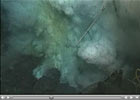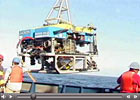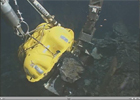Jason is a two-body ROV system. A 10-kilometer (6-mile) fiber-optic tether delivers electrical power and commands from the ship through Medea and down to Jason, which then returns data and live video imagery. Medea serves as a shock absorber, buffering Jason from the movements of the ship, while providing lighting and a bird’s eye view of the ROV during seafloor operations. Jason is equipped with sonar imagers, water samplers, video and still cameras, and lighting gear. Jason’s manipulator arms collect samples of rock, sediment, or marine life and place them in the vehicle’s basket or on “elevator” platforms that float heavier loads to the surface. Pilots and scientists work from a control room on the ship to monitor Jason’s instruments and video while maneuvering the vehicle. The average Jason dive lasts 21 hours, though operators have kept the vehicle down for as long as 100 hours. Jason was first launched in 1988, and the system has been used for hundreds of dives to hydrothermal vents in the Pacific, Atlantic, and Indian Oceans. ROV Jason is now in its second generation, with a sturdier, more advanced vehicle having been launched in 2002. The ROV also has had a successful side career in underwater archeology. A prototype version named Jason Jr. was used to survey the wreck of RMS Titanic, and the fully developed Jason visited a 1,600-year-old Roman trading ship in 1989. Jason and Medea are named for the adventurous ocean explorer of Greek mythology and for his wife. Related Multimedia NW Rota 2009 Expedition to the Mariana Volcanic Arc
NW Rota 2009 Expedition to the Mariana Volcanic ArcApril 3-17, 2009 An international science team studied an erupting undersea volcano near the Island of Guam and captured dramatic new video and still images of the eruptive activity of NW Rota-1.  ROV Jason
ROV JasonWHOI Engineer Will Sellers talks about the latest generation of sub-sea exploration vehicle ROV Jason. » iPod compatible » MP3 (audio) » View Video (Quicktime) » View Video (Media Player)  Jason to the Rescue
Jason to the RescueThe robotic undersea vehicle frees instruments glued to the seafloor by hardened lava. » View Video (Quicktime) Last updated: May 5, 2009 | |||||||||||||
Copyright ©2007 Woods Hole Oceanographic Institution, All Rights Reserved. Contact | Privacy Policy | Site Map | RSS | Support WHOI Research | Internal |